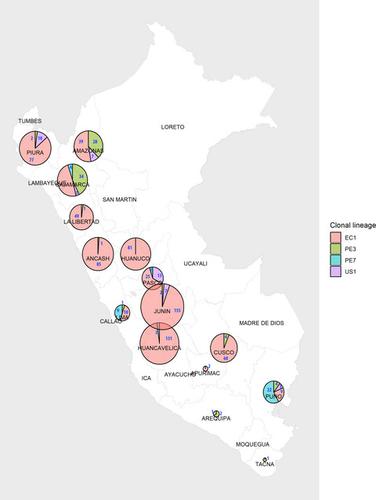当前位置:
X-MOL 学术
›
Plant Pathol.
›
论文详情
Our official English website, www.x-mol.net, welcomes your
feedback! (Note: you will need to create a separate account there.)
Population structure and host range of the potato late blight pathogen Phytophthora infestans in Peru spanning two decades
Plant Pathology ( IF 2.3 ) Pub Date : 2019-12-19 , DOI: 10.1111/ppa.13125 H. Lindqvist‐Kreuze 1 , S. Gamboa 1 , M. Izarra 1 , W. Pérez 1 , M. Y. Correa 1 , A. Astete 1 , T. Särkinen 2 , M. Cueva 3 , P. Gonzáles 3
Plant Pathology ( IF 2.3 ) Pub Date : 2019-12-19 , DOI: 10.1111/ppa.13125 H. Lindqvist‐Kreuze 1 , S. Gamboa 1 , M. Izarra 1 , W. Pérez 1 , M. Y. Correa 1 , A. Astete 1 , T. Särkinen 2 , M. Cueva 3 , P. Gonzáles 3
Affiliation

|
The genetic diversity of the late blight pathogen Phytophthora infestans infecting cultivated potato and alternative hosts growing in the vicinity of fields in the main potato‐growing areas of the Peruvian Andes was characterized using collections from 1997–2013 as reference. The Peruvian P. infestans population, including previously collected and current isolates, consists of four clonal lineages (EC‐1, US‐1, PE‐3 and PE‐7) that belong to the A1 mating type and have been present in the country for decades. The first report of US‐1 was in isolates collected between 1982 and 1986; meanwhile, EC‐1 and PE‐3 appeared for the first time in isolates from 1992 and PE‐7 was found in 1997. The pathogen has a very broad host range among the solanaceous plants infecting cultivated potato, tomato, pear melon and several wild species. The solanaceous species growing in the vicinity of the potato fields sampled were identified and surveyed for late blight‐like symptoms. Phytophthora infestans was isolated from nine wild species, including three new host species: Solanum zahlbruckneri, Solanum grandidentatum and Iochroma grandiflorum. There was no clear host specialization, but geographical substructuring was found as well as changes in the pathogen populations at the regional level. The clonal lineage EC‐1, which is mostly resistant to metalaxyl, has complex virulence and contains a high level of subclonal variation, continues to dominate the population. Some multilocus genotypes of the EC‐1 lineage were sampled in high frequencies and were found among the previously collected and new samples.
中文翻译:

秘鲁马铃薯晚疫病病原菌疫霉的种群结构和寄主范围跨越了二十年
利用1997-2013年的样本作为参考,鉴定了晚疫病病原疫霉感染了栽培马铃薯和秘鲁安第斯山脉主要马铃薯种植区附近田间种植的替代寄主的遗传多样性。秘鲁疫霉种群,包括先前收集的和当前的分离株,由四个克隆谱系(EC-1,US-1,PE-3和PE-7)组成,属于A1交配类型,已经在该国存在了数十年。US-1的第一份报告是在1982年至1986年之间收集的。同时,EC-1和PE-3在1992年的分离物中首次出现,而PE-7在1997年被发现。在茄科植物中,病原体具有非常广泛的宿主范围,感染栽培的马铃薯,番茄,梨瓜和几种野生植物。种类。确定了在采样的马铃薯田附近生长的茄科物种,并调查了晚疫病状症状。疫霉疫霉是从9种野生物种中分离得到的,其中包括3种新的寄主物种:茄属zahlbruckneri,大茄属和大花chrom。目前尚无明确的宿主专业化信息,但发现了地域结构以及区域一级病原菌种群的变化。EC-1克隆谱系主要对甲霜灵具有抗性,具有复杂的毒力,并含有高水平的亚克隆变异,继续占据种群的主导地位。EC-1谱系的一些多基因座基因型以高频率采样,并在先前收集的样本和新样本中发现。
更新日期:2019-12-19
中文翻译:

秘鲁马铃薯晚疫病病原菌疫霉的种群结构和寄主范围跨越了二十年
利用1997-2013年的样本作为参考,鉴定了晚疫病病原疫霉感染了栽培马铃薯和秘鲁安第斯山脉主要马铃薯种植区附近田间种植的替代寄主的遗传多样性。秘鲁疫霉种群,包括先前收集的和当前的分离株,由四个克隆谱系(EC-1,US-1,PE-3和PE-7)组成,属于A1交配类型,已经在该国存在了数十年。US-1的第一份报告是在1982年至1986年之间收集的。同时,EC-1和PE-3在1992年的分离物中首次出现,而PE-7在1997年被发现。在茄科植物中,病原体具有非常广泛的宿主范围,感染栽培的马铃薯,番茄,梨瓜和几种野生植物。种类。确定了在采样的马铃薯田附近生长的茄科物种,并调查了晚疫病状症状。疫霉疫霉是从9种野生物种中分离得到的,其中包括3种新的寄主物种:茄属zahlbruckneri,大茄属和大花chrom。目前尚无明确的宿主专业化信息,但发现了地域结构以及区域一级病原菌种群的变化。EC-1克隆谱系主要对甲霜灵具有抗性,具有复杂的毒力,并含有高水平的亚克隆变异,继续占据种群的主导地位。EC-1谱系的一些多基因座基因型以高频率采样,并在先前收集的样本和新样本中发现。











































 京公网安备 11010802027423号
京公网安备 11010802027423号